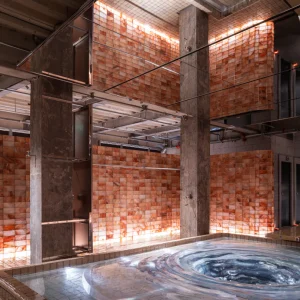The renovation of the school, which houses 1,400 students, aims at creating a modern, visually attractive school with state-of-the-art educational facilities. The renovation encompasses the construction of a new, three storey 20,000 square feet addition to the main building, reprogramming of the existing three-storey school structure, demolition of the separate pre-K building, and construction of new outdoor sports facilities, including six professional-grade tennis courts and a football field with FieldTurf synthetic sport surface, lighting and spectator bleachers.
Construction of the addition and exterior renovations will include replacing the deteriorated concrete shades with aluminum screens which will present a similar massing and façade flow as the original building. It will appear less monolithic and more contemporary than the old structure.
The major engineering challenges included developing a structural design that would provide the necessary lateral force resistance at the new building’s grade level that is very open and features limited exterior walls. About 12-inch shear walls and two columns on the ground level were designed to address poor soil condition. The higher floors feature bearing CMU walls and four concrete beams on each floor.
Due to the low bearing soil, the addition’s foundation system incorporates 128 auger cast piles. The design calls for piles to be topped with reinforced concrete caps, which vary in size from six by six feet and three feet three inches deep to nine by 23 feet and three feet three inches deep. The structural system also includes pre-cast concrete plank floors and pre-cast concrete plank roof structure as well as concrete columns and concrete beams. The masonry walls on the second and third floors will be constructed of concrete masonry units (CMUs).
The roadways are also reconfigured within the high school’s campus. The main entrance has been relocated from Laguna Drive West to Blackheath Road and locations of surface parking spaces have been revised. A mall-like, pedestrian area on the former roadway running between the main high school structure and the gymnasium building has been created. The mall will feature decorative pavement elements, including stamped and colored asphalt areas, and new sidewalks.
Another area for student interaction will be located near the new entrance to the athletic fields. Designed in a plaza setting, it will feature benches and bicycle racks.
One of the civil engineering challenges was the low elevation of the entire campus site. This called for developing a creative drainage system design and increasing the elevation of the sports fields. Chazen designed a new, shallow drainage system for the majority of the site that incorporates new piping, a hydrodynamic storm water separator, a new underdrain system beneath the athletic fields, and a six-inch deep, 170 feet long and 10 feet wide wet swale for collection of runoff water from the handball courts batting cages. The wet swell pool is landscaped with low maintenance grass and provides inexpensive, natural storm water retention without excluding the area from other uses.
The underdrain system in the athletic fields’ area collects the water runoff through composite trench and collection drains, which eventually connect to the remainder of the campus’ drainage infrastructure. In addition, the system features over 1,000 linear feet of French drains composed of perforated pipes placed in gravel-filled trenches along the berms on the western and southern edges of the site.
The addition’s second and third floors will house regular and special education classrooms, media and audio-visual facilities and offices. Parking spaces will occupy the first floor. The addition’s façade will feature coloured architectural cement board panels as a rain screen and high efficiency curtain wall and windows with anodized aluminum frames. On the building’s roof, the crews will install the ethylene propylene diene monome membrane.
In the following phase, the deteriorated three feet wide concrete outriggers will be replaced with sunshade panels installed on the south and east sides of the existing high school. New, clear anodized aluminum shade panels to match the colour of the new window frames for architectural consistency, will rest on the steel supports. The sunshades, custom manufactured by Atoms Architectural Products, will feature extruded aluminum, airfoil-shaped blades with bullnose fascias. In total, Stalco will install in excess of 1,400 linear feet of new sunshades.
The two buildings will be connected through expansion joints on the second, third and roof levels. The new steel framing will be installed in the concrete wall of the original building’s second and third floors. The framing will support new concrete slabs, protruding out by two feet and eight inches. The concrete protrusions will allow seamless internal connections between the two buildings.
The renovation of the existing school will include the conversion of the math department facilities and classrooms into chemistry classrooms; renovations to the special education rooms; and conversion of the 12 existing general science rooms into four biology, four earth science, and four physics classrooms.
The guidance counselor’ and nurse’s offices within the existing structure will also be refitted. The work will encompass a complete renovation of the entire administrative section. The new offices will provide daylight access throughout the entire space that will be achieved through installation of glazed corridor and divider walls. Occupancy sensors will control the lighting in the office area.
The science rooms will feature custom-fabricated millwork cabinetry and lab stations with epoxy tops, data connections and water, power, gas and dedicated chemical waste lines. The waste lines will terminate in a new acid waste tank filled with limestone chips. The administrative area will feature pre-manufactured cabinetry and furniture systems.
In the upcoming phases of the project, a freestanding former pre-K building, which originally served as army barracks, will be demolished. Once the structure is demolished, construction of the sports facilities will proceed, including six professional grade tennis courts and a full-size football field. The field will feature the FieldTurf synthetic sport surface and new, 50-yard-wide, 30-foot-deep spectator bleachers. The bleachers’ structure will consist of micro piles and reinforced concrete columns.
The high school project is scheduled for completion in 2014, which will be completed in 10 phases. The expansion and renovations to the Long Beach High School is a part of $98.9 million Long Beach City Schools Capital Improvement Program. In addition to architect CS Arch, the project team includes general contractor Stalco Construction, construction manager Savin Engineers, P.C.; structural engineer Ryan-Biggs Associates, PC; MEP (mechanical, electrical, plumbing) engineer Lewis Engineering, P.C., civil engineer The Chazen Companies; and athletic facilities consultant HMH Site & Sports Design.





